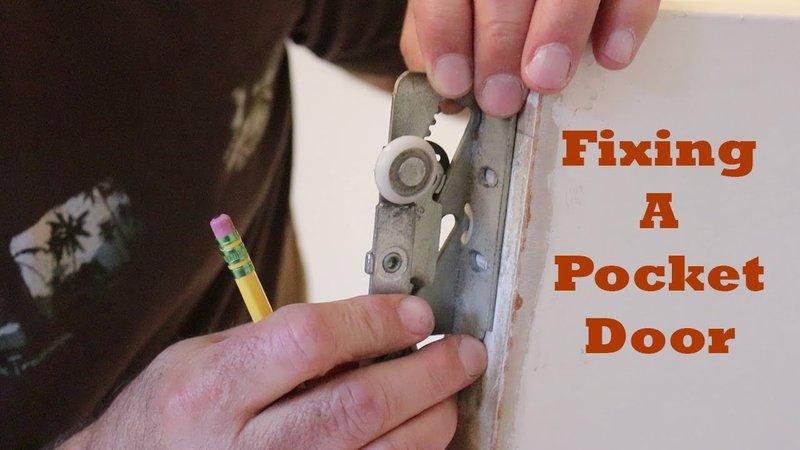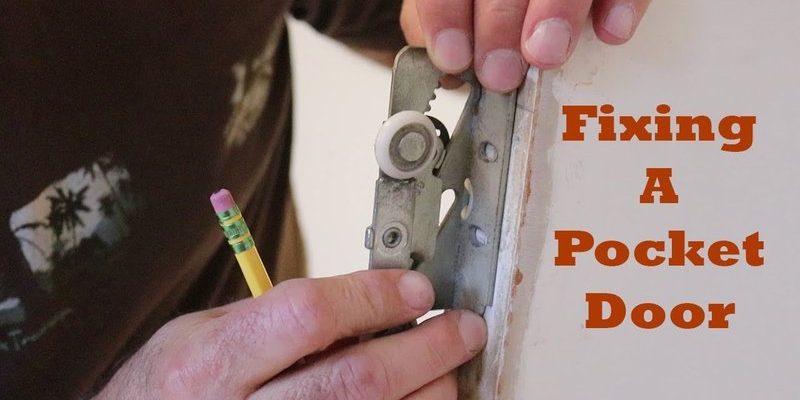
Think of your pocket door as a train on a track. For the train to move smoothly, the track must be clear, clean, and well-maintained. In this case, your door’s track may need some attention. Whether it’s dirt buildup, misalignment, or even something more mechanical, we’ll explore each issue step by step, so you can glide that door with ease again.
Understanding Pocket Door Mechanics
To troubleshoot your pocket door, you first need to understand how it works. Pocket doors slide on a track that’s typically mounted inside the wall. When you pull the door, it moves along this track, much like a car on a highway. If you encounter resistance, it usually means something along this path needs your attention.
Most pocket doors have a roller system at the top. These rollers help the door slide open and closed smoothly. Over time, however, they can wear out, get misaligned, or, worse, collect dust and debris. It’s like trying to drive a car with a flat tire; it just won’t work right.
Knowing the parts of your door and track is key to figuring out why it’s acting up. Make sure you’re familiar with the terminology, such as the track, rollers, and door jamb. This knowledge will be handy as we dive into the nitty-gritty of troubleshooting.
Common Issues with Pocket Doors
There are several reasons why your pocket door might be hard to slide. Here are some common culprits:
- Dirt and Dust: Over time, your pocket door track can accumulate dirt, dust, and debris. This buildup can create friction, making it harder for the rollers to slide.
- Misalignment: Sometimes, the door can shift out of alignment. This can happen due to normal wear and tear or if something nudges it out of place.
- Worn Rollers: The rollers themselves can wear out, losing their ability to glide smoothly.
- Warped Door or Track: If your door or track has warped—often due to humidity or changes in temperature—this can lead to sliding issues.
- Obstructions: Something might be physically blocking the door from sliding fully, like a loose screw or even items behind the wall.
All these factors can contribute to your pocket door behaving more like a stubborn elephant than a nifty sliding door. Identifying the specific problem is the first step toward fixing it.
Step 1: Cleaning the Track
One of the easiest fixes is to clean the track. You’ll be surprised how much dust can build up and disrupt the smooth operation of your pocket door. Here’s how to do it:
1. Gather Supplies: You’ll need a vacuum, a cloth, and possibly some all-purpose cleaner.
2. Vacuum the Track: Use the vacuum to remove loose dust and debris. This is crucial because loose particles can cause the rollers to jam.
3. Wipe Down: Use a damp cloth to clean the track. If it’s particularly dirty, add some cleaner, but make sure to dry it afterward.
4. Lubricate: Once the track is clean, apply a silicone-based lubricant to allow the rollers to glide smoothly. Avoid oil-based lubricants, as they can attract more dust.
Pro tip: Cleaning and lubricating your track every few months can prevent buildup, making it easier to slide your pocket door in the long run.
Step 2: Checking for Misalignment
If cleaning the track didn’t solve the problem, the next step is to check if the door is misaligned. Misalignment can be tricky to spot, but it’s often the reason your door feels off.
1. Inspect the Door Position: Close the door and see if it lines up with the frame. It should sit evenly within the jamb.
2. Look at the Rollers: Open the door slightly and check if the rollers are seated properly in the track. If they’re off, they may need to be adjusted.
3. Adjust the Door if Needed: Many pocket doors have height-adjustable rollers. Look for screws on the rollers that can be tightened or loosened to align the door correctly.
If the door is still misaligned after adjustments, it could be that the track is warped or the door itself might be bowed.
Step 3: Inspecting and Replacing Rollers
Old or damaged rollers could be a significant reason your pocket door is hard to slide. If cleaning and alignment checks didn’t do the trick, it’s time to inspect the rollers.
1. Remove the Door: You may need to take the door off the track to access the rollers. This usually involves lifting the door out of the track. Be careful while doing this—some pocket doors can be heavy!
2. Examine the Rollers: Check for signs of wear, rust, or damage. If they look worn out or broken, it’s best to replace them.
3. Buy New Rollers: Visit a hardware store to find matching rollers. Bring the old ones with you to ensure you get the right size.
4. Install New Rollers: Follow the manufacturer’s instructions to install the new rollers. Once they’re in place, rehang the door and test its movement.
Replacing rollers can dramatically improve how easily the door slides. It’s like swapping out old shoes for a fresh pair—it makes a world of difference!
Step 4: Fixing Warped Tracks or Doors
If your door or track has warped, this can be a tougher issue to address. Luckily, there are a few strategies to consider.
1. Assess the Damage: Check if the warping is minor or severe. Minor warping can sometimes be fixed, while severe cases might require replacement.
2. Try Adjusting the Track: If the track is slightly warped, you might be able to gently bend it back into shape. Use pliers or a wrench, but be cautious not to break it.
3. Replace if Necessary: If the warping is significant, you may need to replace the track. Similarly, if the door is warped, consider having it planed down or replaced entirely.
Repairing or replacing warped components can restore smooth functionality to your pocket door.
Step 5: Assessing for Obstructions
Lastly, it’s always a good idea to check for any obstructions that might be blocking the door’s path. Sometimes, it’s the simplest fixes that save the day.
1. Inspect Behind the Door: Check for any items stored in the wall cavity that might be interfering with the door’s movement.
2. Look at the Hinges and Screws: Ensure there are no loose screws or loose parts that could impede the movement of your door.
3. Clear the Path: If anything is wedged or caught in the door’s path, safely remove it and test if the door slides more freely after.
You’d be surprised how many issues can be resolved just by clearing the way!
Troubleshooting a pocket door that is hard to slide on its track can seem daunting. However, with a little patience and the right approach, you can get it gliding smoothly again. Whether it’s cleaning the track, adjusting, or replacing parts, each step can make a significant difference.
Remember, regularly checking and maintaining your pocket door can prevent these problems from arising in the first place. So make a note in your calendar to give it some TLC every now and then. With these tips in mind, you’re now ready to tackle any stubborn pocket door issues that come your way!
